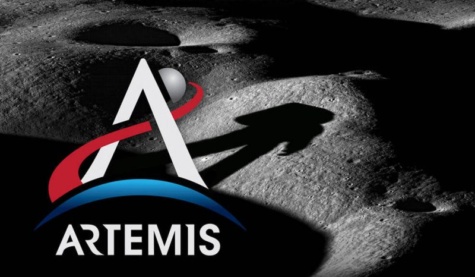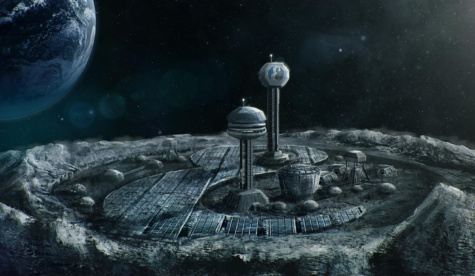
Eden Milligan | Editor-in-Chief
September 24, 2021
The last time a human set foot on the moon was December 19, 1972. Now, a series of missions organized by NASA, beginning in December of this year, aims to send people back by 2024. This time, the goal isn’t just to show off our science or even collect moon samples–this time, NASA will be examining the real estate on which they might build a future community and using the moon to inform research of how to create a sustained presence on Mars one day.
The prospect of sustained human life outside of Earth is certainly frightening. Some worry that the depletion of natural resources and general disregard for the well-being of the environment that humans have shown on Earth will continue in space, arguing that permanent settlements off of our home planet should be avoided. NASA and other space travel organizations, however, disagree. Exploration of space may not be justifiable without concrete goals, as the research conducted outside of Earth, though fascinating, is expensive.
“Knowledge of the Moon isn’t useful unless we utilize it,” senior Jason Herrmann said. “Knowing the Moon’s processes inside and out might be interesting, but it’s entirely useless and a waste of money and resources if we don’t have a greater goal in mind like settling on it or practicing for a settlement on Mars.”

According to NASA, the 50 year gap in lunar travel following the 1972 moon mission was caused by budgeting issues and a lack of political support. It seemed impractical to spend billions of dollars to return to the moon’s surface, since, to the general public at least, there didn’t seem to be much more to examine there. Things have changed. Ice was discovered at the moon’s poles.
While the presence of ice on the moon was long speculated, it was’t until NASA’s Moon Mineralogy Mapper instrument, launched by the Indian Chandrayaan-1 spacecraft in 2008, collected data on light reflection and infrared absorption on the surface of the moon that lunar ice was officially discovered. This sent ripples around the scientific community, as water is essential for all life on Earth. Ice on the moon (and perhaps extractable ice beneath the moon’s surface) means that humans could potentially exist on the moon for extended periods of time, given that scientists are able to harvest and use the resource. Since space travel is such a precise science, and every ounce of cargo weight–including weight in water provisions–counts, moon water could be the key to life on the lunar surface.
In order to collect more data about the prevalence of water on the moon, NASA plans to launch its Volatiles Investigating Polar Exploration Rover (VIPER) via a SpaceX rocket in 2023. VIPER will land at the moon’s south pole–one of the coldest regions in our solar system. The dark craters of the moon where ice can be found can even drop to -414 degrees Fahrenheit (for reference, the temperature of -459.67 is the coldest that humans have been able to reach).
In addition to water, one massive requirement for sustained human life is energy, which, NASA has decided, should come from solar energy collected at peaks on the light side of the moon, which are almost eternally exposed to the sun. Unsurprisingly, energy is another major point of focus for the Artemis missions.
Aside from research in space, Artemis also has a goal of promoting diversity and making social progress by landing the first woman and person of color on the moon.
It seems to be a great time of collaboration and progress in space. India and the United States worked together to confirm the presence of moon ice, and now NASA will work alongside SpaceX to pursue further research. Given the advancements made by space engineers and scientists (which could actually make a rover trip to a near-absolute zero temperature possible) and the discoveries of essential resources on the moon, perhaps it isn’t so insane to think that a moon community could be established in the relatively-near future. We can only hope to learn from our mistakes on Earth as we progress into this new era of colonization.
“In the vein of the responsibility of humans to maintain the solar system, I think that we definitely should aim to preserve our space neighborhood [the solar system] as much as we possibly can for the sake of future generations, but the track record for humans preserving planets is not pristine,” Herrmann said.

Environmental sustainability may be especially difficult to achieve considering the eventual goal of commercialization of space travel, which is supported by major space organizations such as NASA and SpaceX. However, with so much still left to learn, it is hard to fathom how soon this dream–or, from a preservation perspective, possible nightmare–will be realized.
“The commercialization of space is a concept that seems incredibly far away to me,” senior Logan Hardison said. “I honestly don’t think that it will happen during my lifetime, but if it does, then I will welcome it and not fear it,” he added. That is, “as long as we [pursue space exploration] in a smart and friendly way that preserves the environment.”
Despite the looming challenges–both technological and environmental–related to settling the moon and Mars, the nearing future of the next space age is undeniably exciting. And yet, humans’ relationship to space is complicated by the neglect our species has shown for our own planet. With climate change accelerating at a frightening pace and wreaking havoc around the globe, is this really the best time to go to space? The public’s opinions are divided.
Hardison believes that “now is as good a time as ever to begin a new age of exploration,” while Herrmann is more skeptical.
“I entirely enjoy the thought of eventually being able to travel the solar system in a commercial spacecraft,” he said, “but I can’t help but think that the efforts and funds allocated toward this push for space probably could and should be better utilized in solving the issues that occur on the planet that humans have inhabited for thousands of years. In the aspect of its fantasy, I’d say it’s brilliant and exciting, but it frightens me to think that some believe life on other worlds is more viable than fixing our problems on Earth.”
Whether or not it’s the right decision, the Artemis mission is already underway, with 37 launches planned for the near future.

Leave a Reply